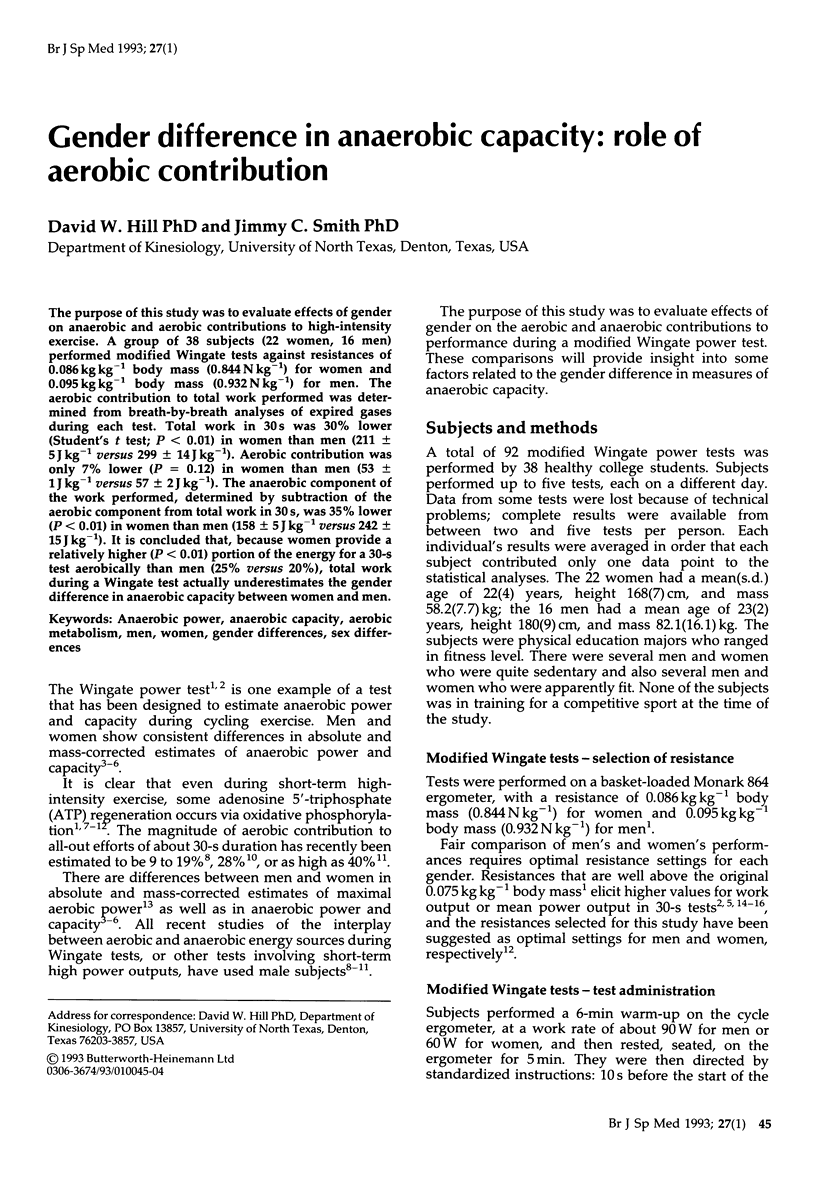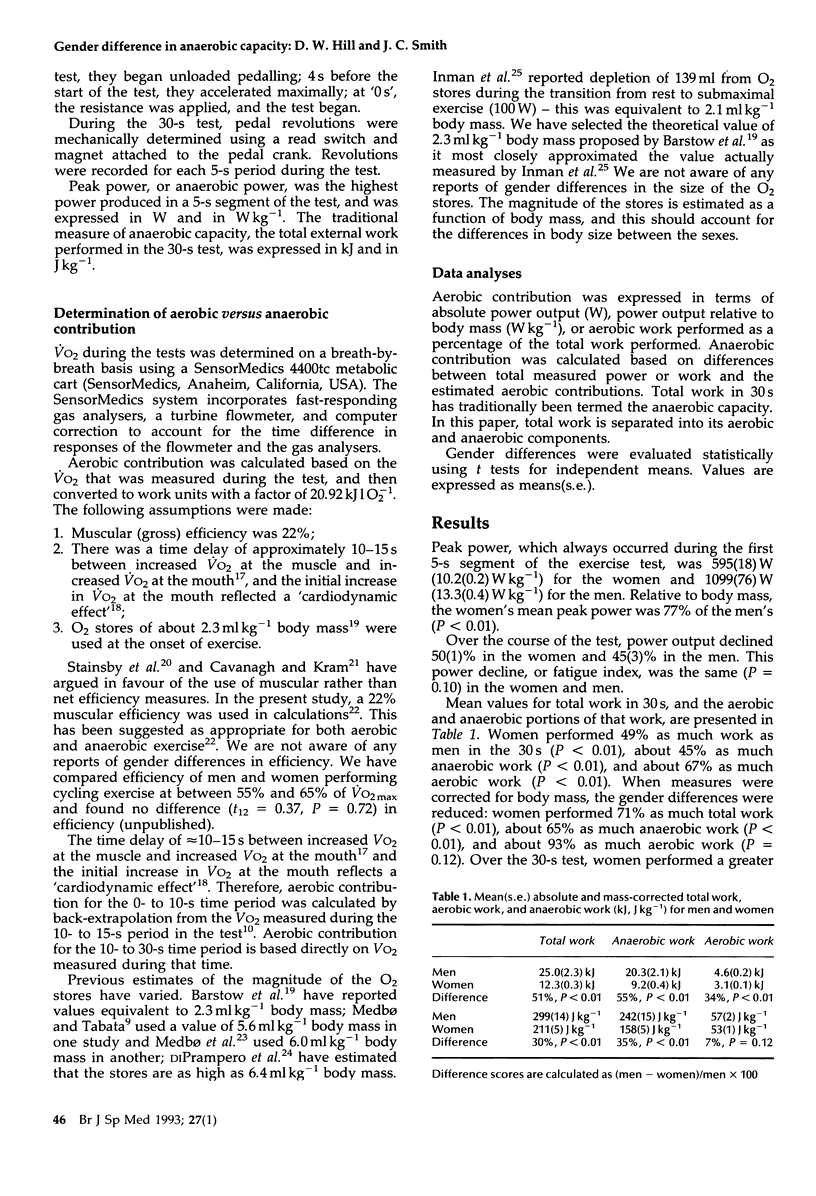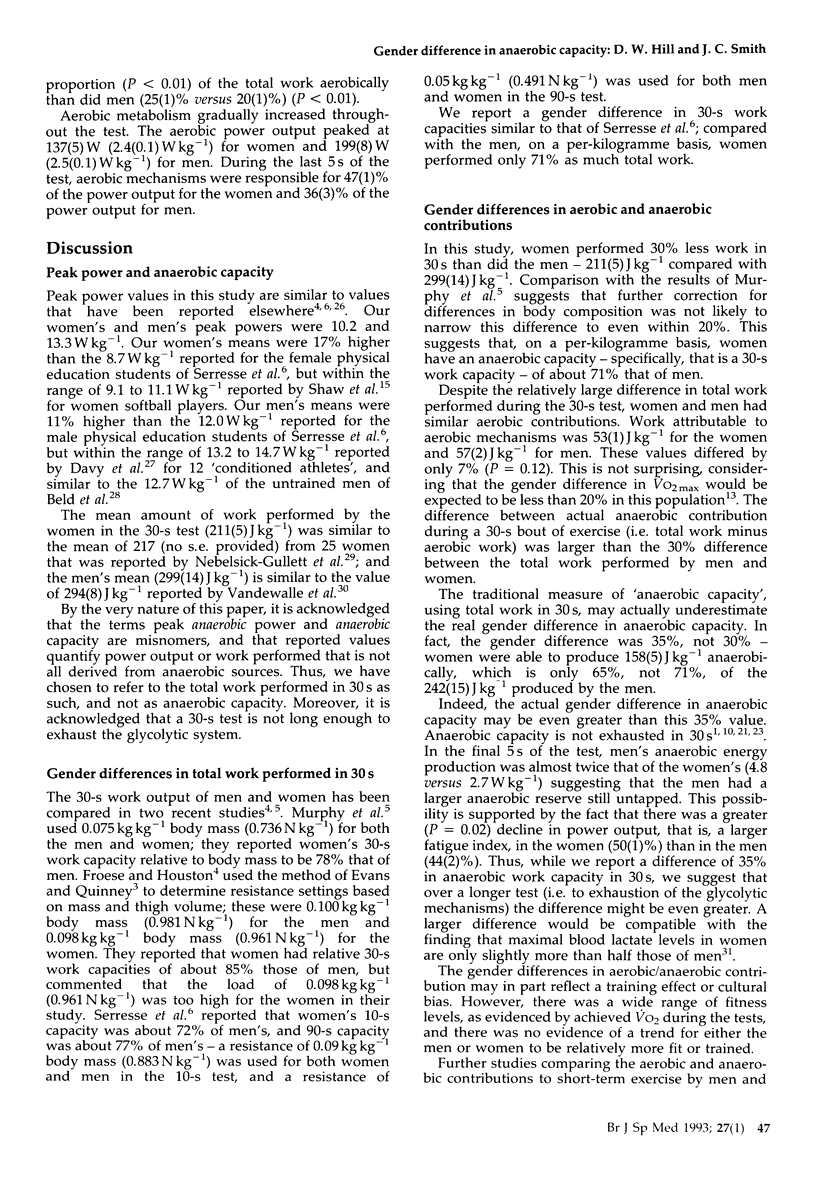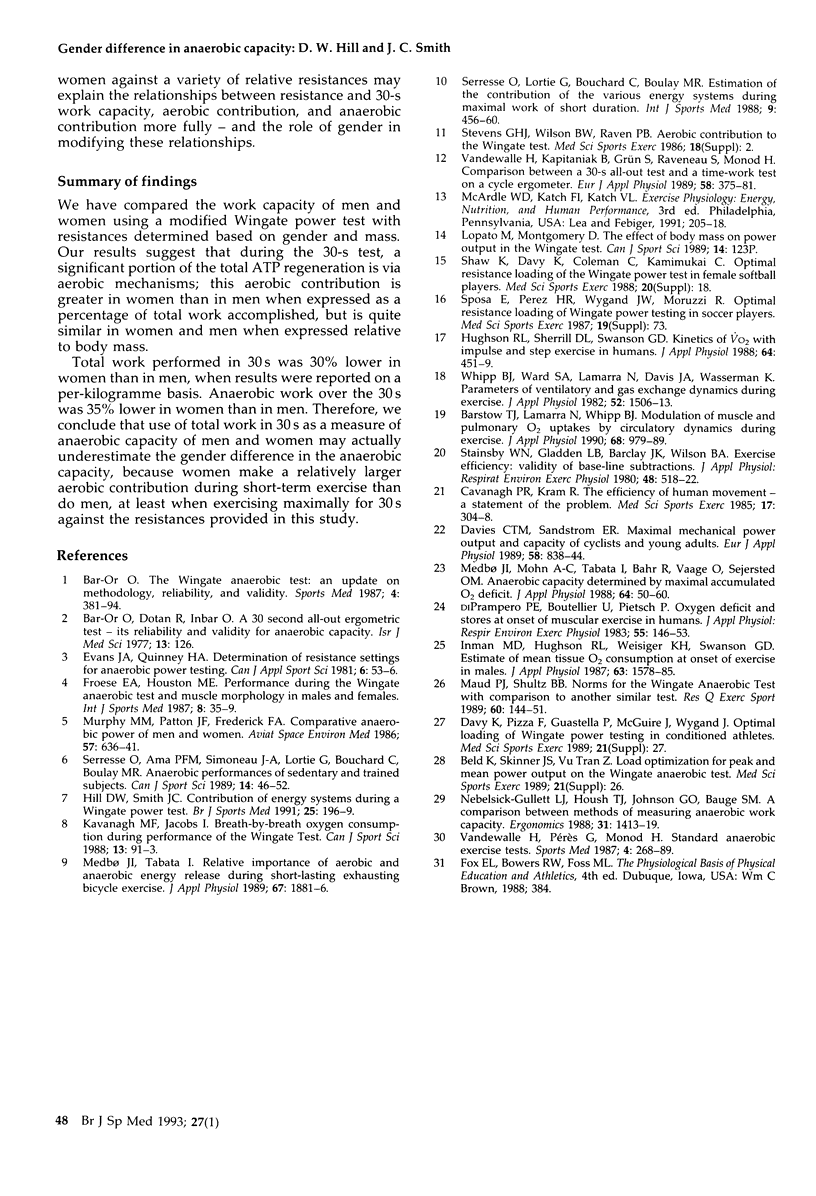Abstract
The purpose of this study was to evaluate effects of gender on anaerobic and aerobic contributions to high-intensity exercise. A group of 38 subjects (22 women, 16 men) performed modified Wingate tests against resistances of 0.086 kg kg-1 body mass (0.844 N kg-1) for women and 0.095 kg kg-1 body mass (0.932 N kg-1) for men. The aerobic contribution to total work performed was determined from breath-by-breath analyses of expired gases during each test. Total work in 30 s was 30% lower (Student's t test; P < 0.01) in women than men (211 +/- 5 J kg-1 versus 299 +/- 14 J kg-1). Aerobic contribution was only 7% lower (P = 0.12) in women than men (53 +/- 1 J kg-1 versus 57 +/- 2 J kg-1). The anaerobic component of the work performed, determined by subtraction of the aerobic component from total work in 30 s, was 35% lower (P < 0.01) in women than men (158 +/- 5 J kg-1 versus 242 +/- 15 J kg-1). It is concluded that, because women provide a relatively higher (P < 0.01) portion of the energy for a 30-s test aerobically than men (25% versus 20%), total work during a Wingate test actually underestimates the gender difference in anaerobic capacity between women and men.
Full text
PDF



Selected References
These references are in PubMed. This may not be the complete list of references from this article.
- Bar-Or O. The Wingate anaerobic test. An update on methodology, reliability and validity. Sports Med. 1987 Nov-Dec;4(6):381–394. doi: 10.2165/00007256-198704060-00001. [DOI] [PubMed] [Google Scholar]
- Barstow T. J., Lamarra N., Whipp B. J. Modulation of muscle and pulmonary O2 uptakes by circulatory dynamics during exercise. J Appl Physiol (1985) 1990 Mar;68(3):979–989. doi: 10.1152/jappl.1990.68.3.979. [DOI] [PubMed] [Google Scholar]
- Cavanagh P. R., Kram R. The efficiency of human movement--a statement of the problem. Med Sci Sports Exerc. 1985 Jun;17(3):304–308. [PubMed] [Google Scholar]
- Davies C. T., Sandstrom E. R. Maximal mechanical power output and capacity of cyclists and young adults. Eur J Appl Physiol Occup Physiol. 1989;58(8):838–844. doi: 10.1007/BF02332216. [DOI] [PubMed] [Google Scholar]
- Di Prampero P. E., Boutellier U., Pietsch P. Oxygen deficit and stores at onset of muscular exercise in humans. J Appl Physiol Respir Environ Exerc Physiol. 1983 Jul;55(1 Pt 1):146–153. doi: 10.1152/jappl.1983.55.1.146. [DOI] [PubMed] [Google Scholar]
- Dubowitz B. Contribution of histochemistry to the diagnosis of muscle pathology. Isr J Med Sci. 1977 Feb;13(2):126–130. [PubMed] [Google Scholar]
- Evans J. A., Quinney H. A. Determination of resistance settings for anaerobic power testing. Can J Appl Sport Sci. 1981 Jun;6(2):53–56. [PubMed] [Google Scholar]
- Froese E. A., Houston M. E. Performance during the Wingate anaerobic test and muscle morphology in males and females. Int J Sports Med. 1987 Feb;8(1):35–39. doi: 10.1055/s-2008-1025637. [DOI] [PubMed] [Google Scholar]
- Hughson R. L., Sherrill D. L., Swanson G. D. Kinetics of VO2 with impulse and step exercise in humans. J Appl Physiol (1985) 1988 Jan;64(1):451–459. doi: 10.1152/jappl.1988.64.1.451. [DOI] [PubMed] [Google Scholar]
- Inman M. D., Hughson R. L., Weisiger K. H., Swanson G. D. Estimate of mean tissue O2 consumption at onset of exercise in males. J Appl Physiol (1985) 1987 Oct;63(4):1578–1585. doi: 10.1152/jappl.1987.63.4.1578. [DOI] [PubMed] [Google Scholar]
- Kavanagh M. F., Jacobs I. Breath-by-breath oxygen consumption during performance of the Wingate Test. Can J Sport Sci. 1988 Mar;13(1):91–93. [PubMed] [Google Scholar]
- Maud P. J., Shultz B. B. Norms for the Wingate anaerobic test with comparison to another similar test. Res Q Exerc Sport. 1989 Jun;60(2):144–151. doi: 10.1080/02701367.1989.10607429. [DOI] [PubMed] [Google Scholar]
- Medbø J. I., Mohn A. C., Tabata I., Bahr R., Vaage O., Sejersted O. M. Anaerobic capacity determined by maximal accumulated O2 deficit. J Appl Physiol (1985) 1988 Jan;64(1):50–60. doi: 10.1152/jappl.1988.64.1.50. [DOI] [PubMed] [Google Scholar]
- Medbø J. I., Tabata I. Relative importance of aerobic and anaerobic energy release during short-lasting exhausting bicycle exercise. J Appl Physiol (1985) 1989 Nov;67(5):1881–1886. doi: 10.1152/jappl.1989.67.5.1881. [DOI] [PubMed] [Google Scholar]
- Murphy M. M., Patton J. F., Frederick F. A. Comparative anaerobic power of men and women. Aviat Space Environ Med. 1986 Jul;57(7):636–641. [PubMed] [Google Scholar]
- Nebelsick-Gullett L. J., Housh T. J., Johnson G. O., Bauge S. M. A comparison between methods of measuring anaerobic work capacity. Ergonomics. 1988 Oct;31(10):1413–1419. doi: 10.1080/00140138808966785. [DOI] [PubMed] [Google Scholar]
- Serresse O., Ama P. F., Simoneau J. A., Lortie G., Bouchard C., Boulay M. R. Anaerobic performances of sedentary and trained subjects. Can J Sport Sci. 1989 Mar;14(1):46–52. [PubMed] [Google Scholar]
- Serresse O., Lortie G., Bouchard C., Boulay M. R. Estimation of the contribution of the various energy systems during maximal work of short duration. Int J Sports Med. 1988 Dec;9(6):456–460. doi: 10.1055/s-2007-1025051. [DOI] [PubMed] [Google Scholar]
- Smith J. C., Hill D. W. Contribution of energy systems during a Wingate power test. Br J Sports Med. 1991 Dec;25(4):196–199. doi: 10.1136/bjsm.25.4.196. [DOI] [PMC free article] [PubMed] [Google Scholar]
- Stainbsy W. N., Gladden L. B., Barclay J. K., Wilson B. A. Exercise efficiency: validity of base-line subtractions. J Appl Physiol Respir Environ Exerc Physiol. 1980 Mar;48(3):518–522. doi: 10.1152/jappl.1980.48.3.518. [DOI] [PubMed] [Google Scholar]
- Vandewalle H., Kapitaniak B., Grün S., Raveneau S., Monod H. Comparison between a 30-s all-out test and a time-work test on a cycle ergometer. Eur J Appl Physiol Occup Physiol. 1989;58(4):375–381. doi: 10.1007/BF00643512. [DOI] [PubMed] [Google Scholar]
- Vandewalle H., Pérès G., Monod H. Standard anaerobic exercise tests. Sports Med. 1987 Jul-Aug;4(4):268–289. doi: 10.2165/00007256-198704040-00004. [DOI] [PubMed] [Google Scholar]
- Whipp B. J., Ward S. A., Lamarra N., Davis J. A., Wasserman K. Parameters of ventilatory and gas exchange dynamics during exercise. J Appl Physiol Respir Environ Exerc Physiol. 1982 Jun;52(6):1506–1513. doi: 10.1152/jappl.1982.52.6.1506. [DOI] [PubMed] [Google Scholar]


